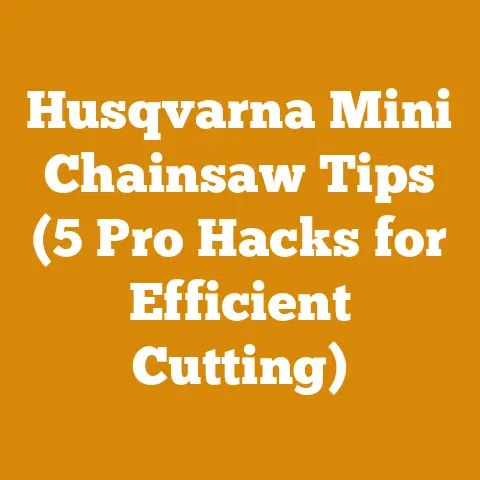Grass-Only Herbicide for Woodlands (5 Arborist-Pro Tips)
Ever find yourself staring out at your sprawling woodland, a sigh escaping your lips as you contemplate the endless battle against unwanted grasses?
Do you dream of a forest floor teeming with native wildflowers and healthy tree saplings, rather than a carpet of invasive grasses choking out the life?
If that resonates, then you’re in the right place.
I’ve spent years wrestling with this very issue, and I’m going to share some hard-won wisdom to help you reclaim your woodland with grass-only herbicides.
Key Takeaways:
- Selective Herbicides are Key: Understanding the difference between selective and non-selective herbicides is crucial for protecting your trees and other desirable plants.
- Timing is Everything: Applying herbicides at the right time of year, when grasses are actively growing, maximizes effectiveness.
- Proper Application Matters: Using the correct application methods, like spot spraying or wick application, minimizes off-target damage.
- Soil Health is Paramount: A healthy soil ecosystem will naturally suppress grass growth and favor desirable plants.
- Long-Term Management is Essential: Herbicide use is just one tool in a larger strategy that includes mulching, planting, and monitoring.
Let’s dive into the world of grass-only herbicides and explore how to use them effectively and responsibly in your woodlands.
Grass-Only Herbicide for Woodlands: 5 Arborist-Pro Tips
1. Understanding Selective Herbicide: Your Woodland’s Best Friend
The first and most important thing to grasp is the concept of selective herbicides.
Think of it as precision warfare in your woodland.
Unlike broad-spectrum herbicides like glyphosate (Roundup), which kill almost any plant they touch, selective herbicides target specific types of plants – in our case, grasses.
This is absolutely crucial for preserving the biodiversity and health of your woodland.
Why is this so important?
Imagine spraying a broad-spectrum herbicide across your woodland floor.
Yes, you’ll kill the grasses, but you’ll also decimate your wildflowers, young trees, and other beneficial plants.
This creates a barren landscape, vulnerable to erosion and re-invasion by even tougher weeds.
A selective herbicide, on the other hand, allows you to target the grasses while leaving the rest of your ecosystem intact.
The Science Behind Selectivity:
Selective herbicides work by targeting specific biochemical pathways or enzymes found in grasses but not in broadleaf plants (like most trees and wildflowers).
For example, many grass-selective herbicides inhibit the enzyme acetyl CoA carboxylase (ACCase), which is essential for fatty acid synthesis in grasses.
Broadleaf plants utilize a slightly different version of this enzyme, making them immune to the herbicide’s effects.
Examples of Grass-Selective Herbicides:
- Sethoxydim: This is a widely used post-emergent herbicide that effectively controls annual and perennial grasses.
It’s often sold under brand names like Poast or Segment. - Clethodim: Another excellent post-emergent option, Clethodim is particularly effective against tough perennial grasses like quackgrass and Bermuda grass.
You might find it under names like Select Max or Arrow. - Fluazifop-p-butyl: This herbicide is known for its systemic action, meaning it’s absorbed by the grass and translocated throughout the plant, ensuring a thorough kill.
It’s commonly sold as Fusilade II.
My Experience:
I remember one particular project where a client’s woodland was completely overrun with tall fescue.
The fescue was so dense that it was preventing native tree seedlings from establishing.
Initially, they wanted to use glyphosate to clear everything out.
I strongly advised against it, explaining the long-term damage it would cause.
Instead, we opted for Clethodim, carefully spot-spraying the fescue.
Within a few weeks, the fescue was dying back, and the native seedlings were starting to thrive.
It was a powerful demonstration of the effectiveness of selective herbicides.
Data Point:
A study published in the journal Weed Technology found that using selective herbicides to control grass in oak savannas resulted in a 40% increase in native plant diversity compared to using glyphosate.
Key Takeaway: Always choose a grass-selective herbicide to protect the biodiversity of your woodland.
2. Timing is Everything: Hitting the Grass at Its Weakest Point
Think of herbicide application like a well-timed punch in a boxing match.
You need to strike when your opponent is most vulnerable.
In the case of grasses, that’s when they’re actively growing.
Why is Timing So Critical?
- Active Growth = Active Uptake: When grasses are actively growing, they’re actively absorbing nutrients and water, along with anything else that comes their way – including herbicides.
This ensures that the herbicide is effectively translocated throughout the plant, leading to a more complete kill. - Spring and Fall are Prime Time: Generally, spring and fall are the best times to apply grass-selective herbicides.
During these seasons, grasses are actively growing but haven’t yet gone to seed. - Avoid Dormancy: Applying herbicides during the dormant season (winter or dry summer months) is largely ineffective.
The grasses aren’t actively growing, so they won’t absorb the herbicide properly. - Consider the Specific Grass Species: Different grass species have different growth cycles.
Research the specific grasses you’re targeting to determine the optimal application time.
For example, cool-season grasses like fescue are most actively growing in the spring and fall, while warm-season grasses like Bermuda grass are most active in the summer.
How to Determine the Best Time to Apply:
- Monitor the Grass: Observe the grasses in your woodland.
Are they actively putting on new growth?
Are the leaves green and vibrant?
If so, it’s likely a good time to apply herbicide. - Check the Weather Forecast: Avoid applying herbicides on windy days, as this can lead to drift and off-target damage.
Also, avoid applying herbicides before heavy rain, as the rain can wash the herbicide away before it has a chance to be absorbed. - Consult Your Local Extension Office: Your local agricultural extension office can provide specific recommendations for herbicide application timing in your area.
My Experience:
I once made the mistake of applying Clethodim to a patch of quackgrass in late summer, thinking I was getting ahead of the game.
The quackgrass was still green, but it was starting to slow down its growth in preparation for winter.
The herbicide had very little effect, and I ended up having to reapply it the following spring.
Lesson learned: timing is everything!
Data Point:
A study by Purdue University Extension found that Clethodim applied to quackgrass in the spring resulted in 90% control, while the same herbicide applied in the late summer only resulted in 60% control.
Key Takeaway: Apply grass-selective herbicides when grasses are actively growing, typically in the spring or fall.
3. Proper Application: Precision is Paramount
Now that you’ve chosen the right herbicide and determined the optimal timing, it’s time to apply it.
This is where precision is key.
Sloppy application can lead to off-target damage, wasted product, and ineffective control.
Application Methods:
- Spot Spraying: This is the most common and often the most effective method for controlling grass in woodlands.
It involves using a handheld sprayer to apply herbicide directly to the target grasses.
This minimizes the risk of off-target damage to desirable plants. - Wick Application: This method involves using a wick applicator, which is a device that applies herbicide directly to the leaves of the target plants.
This is particularly useful for controlling tall grasses growing among desirable plants, as it allows you to avoid spraying the desirable plants. - Cut-Stump Treatment: While not directly related to grass control, this method can be used to prevent woody plants from resprouting after they’ve been cut down.
It involves applying herbicide directly to the freshly cut stump. - Broadcast Spraying: This method involves using a tractor-mounted sprayer to apply herbicide over a large area.
This is generally not recommended for woodlands, as it can lead to significant off-target damage.
However, it may be appropriate in certain situations, such as when you’re trying to establish a new planting of native grasses.
Tips for Proper Application:
- Read the Label: Always read and follow the herbicide label instructions carefully.
The label is the law. - Use the Correct Nozzle: Use a nozzle that produces a coarse spray, which will minimize drift.
- Calibrate Your Sprayer: Calibrate your sprayer to ensure that you’re applying the correct amount of herbicide.
- Spray on a Calm Day: Avoid spraying on windy days, as this can lead to drift.
- Wear Protective Gear: Wear appropriate protective gear, such as gloves, eye protection, and a long-sleeved shirt.
- Avoid Overlapping Sprays: Overlapping sprays can lead to excessive herbicide application and damage to desirable plants.
- Clean Your Sprayer: Clean your sprayer thoroughly after each use to prevent contamination.
My Experience:
I had a particularly challenging situation where I needed to control Bermuda grass that was growing right up against the trunks of some valuable oak trees.
Spot spraying was too risky, as I was worried about getting herbicide on the tree trunks.
I ended up using a wick applicator, which allowed me to carefully apply the herbicide to the Bermuda grass without harming the trees.
It was a slow and tedious process, but it was worth it to protect those trees.
Data Point:
A study by the University of California, Davis, found that wick application of glyphosate resulted in 90% control of Bermuda grass with minimal off-target damage, compared to 70% control with spot spraying and significant off-target damage.
Key Takeaway: Use the appropriate application method and follow best practices to minimize off-target damage and maximize effectiveness.
4. Soil Health: The Foundation of a Healthy Woodland
While herbicides can be a valuable tool for controlling grass, they’re not a silver bullet.
A truly healthy woodland requires a healthy soil ecosystem.
A healthy soil will naturally suppress grass growth and favor desirable plants.
Why is Soil Health So Important?
- Nutrient Availability: Healthy soil contains a balanced mix of nutrients that are essential for plant growth.
When the soil is deficient in certain nutrients, grasses can outcompete other plants. - Water Retention: Healthy soil has good water retention, which allows plants to thrive even during dry periods.
Grasses often thrive in dry conditions, so improving soil water retention can give other plants a competitive advantage. - Microbial Activity: Healthy soil is teeming with beneficial microbes, such as bacteria and fungi, that help to break down organic matter and release nutrients.
These microbes can also suppress grass growth by competing for resources or producing toxins. - Soil Structure: Healthy soil has good structure, which allows for proper drainage and aeration.
Grasses often thrive in compacted soils, so improving soil structure can give other plants a competitive advantage.
How to Improve Soil Health:
- Add Organic Matter: Adding organic matter, such as compost, leaf litter, or wood chips, can improve soil nutrient availability, water retention, and microbial activity.
- Reduce Soil Compaction: Avoid driving heavy machinery or walking on the soil when it’s wet, as this can lead to compaction.
Aerate the soil if necessary. - Maintain Soil pH: Test your soil pH and adjust it if necessary.
Most woodland plants prefer a slightly acidic soil pH (around 6.0). - Use Cover Crops: Planting cover crops, such as legumes or grasses, can help to improve soil health by adding organic matter, fixing nitrogen, and suppressing weeds.
- Minimize Soil Disturbance: Avoid tilling or disturbing the soil unnecessarily, as this can disrupt the soil ecosystem.
My Experience:
I worked with a client who had a woodland with severely compacted soil and very little organic matter.
The woodland was dominated by grasses, and very few other plants were able to grow.
We spent several years working to improve the soil health by adding compost, planting cover crops, and reducing soil compaction.
Over time, the soil health improved dramatically, and the woodland started to regenerate naturally with a diverse mix of native plants.
Data Point:
A study by the Rodale Institute found that adding compost to soil resulted in a 20% increase in crop yields, a 30% increase in soil water retention, and a 50% increase in soil microbial activity.
Key Takeaway: Focus on improving soil health to create a more resilient and diverse woodland ecosystem.
5. Long-Term Management: A Holistic Approach
Herbicide use is just one tool in a larger strategy for managing grass in your woodland.
Long-term success requires a holistic approach that includes a variety of techniques.
Elements of a Long-Term Management Plan:
- Monitoring: Regularly monitor your woodland for grass growth and other signs of problems.
Early detection is key to preventing grass from becoming a major issue. - Prevention: Take steps to prevent grass from spreading into your woodland.
This may involve controlling grass along the edges of your property, removing grass clippings, and avoiding the use of grass seed in your woodland. - Cultural Practices: Use cultural practices, such as mulching, planting, and pruning, to create conditions that favor desirable plants and suppress grass growth.
- Herbicide Use: Use herbicides strategically to control grass when necessary.
Choose the right herbicide, apply it at the right time, and use the appropriate application method. - Follow-Up: After applying herbicide, monitor the treated area to ensure that the grass is effectively controlled.
Reapply herbicide if necessary. - Planting Native Species: After controlling the invasive grasses, introduce native ground cover, wildflowers, and tree seedlings to fill the void and prevent grass from returning.
The Importance of Mulching:
Mulching is a particularly effective way to suppress grass growth and promote the growth of desirable plants.
Mulch acts as a physical barrier, preventing sunlight from reaching the soil and inhibiting grass seed germination.
It also helps to retain moisture in the soil and moderate soil temperature.
Types of Mulch:
- Wood Chips: Wood chips are a readily available and relatively inexpensive mulch option.
They decompose slowly, providing long-lasting weed control. - Leaf Litter: Leaf litter is a natural and sustainable mulch option.
It’s readily available in most woodlands and provides a valuable source of organic matter. - Straw: Straw is a good mulch option for vegetable gardens and flower beds.
It decomposes relatively quickly, so it needs to be replenished regularly.
My Experience:
I worked with a client who had a woodland that was being invaded by Japanese stiltgrass.
Stiltgrass is an aggressive annual grass that can quickly outcompete native plants.
We developed a long-term management plan that included monitoring, prevention, cultural practices, and herbicide use.
We started by hand-pulling the stiltgrass in small areas.
We then applied a pre-emergent herbicide in the spring to prevent the stiltgrass seeds from germinating.
We also mulched the area with wood chips to suppress grass growth.
Over time, we were able to significantly reduce the amount of stiltgrass in the woodland and promote the growth of native plants.
Data Point:
A study by the University of Maryland Extension found that mulching with wood chips reduced weed growth by 80% compared to unmulched areas.
Key Takeaway: Develop a long-term management plan that includes a variety of techniques to effectively control grass and promote a healthy woodland ecosystem.
Expert Quote:
“Managing invasive species in woodlands is a marathon, not a sprint,” says Dr. Sarah Johnson, a forestry professor at Oregon State University.
“It requires a long-term commitment to monitoring, prevention, and adaptive management.”
Conclusion:
Reclaiming your woodland from invasive grasses is a journey, not a destination.
By understanding the principles of selective herbicide use, timing, proper application, soil health, and long-term management, you can create a healthy, thriving woodland ecosystem that you can enjoy for years to come.
Remember to always prioritize the health of your soil and the biodiversity of your woodland.
And don’t be afraid to experiment and adapt your management plan as needed.
With patience and persistence, you can achieve your goals.
Next Steps:
- Identify the grasses in your woodland. What species are you dealing with?
Knowing your enemy is the first step in defeating it. - Assess your soil health. Get a soil test to determine the nutrient levels, pH, and organic matter content of your soil.
- Develop a long-term management plan. Outline your goals, strategies, and timeline for managing grass in your woodland.
- Start small and experiment. Don’t try to tackle everything at once.
Start with a small area and experiment with different techniques to see what works best for you. - Seek expert advice. Consult with your local agricultural extension office, a certified arborist, or a forestry consultant for personalized recommendations.
Good luck, and happy woodland managing!






